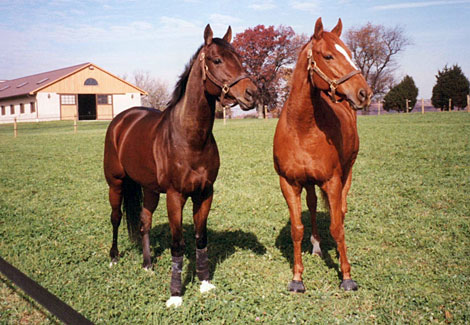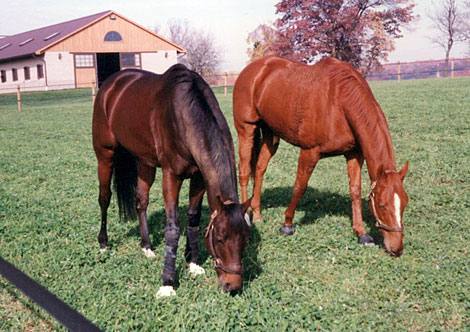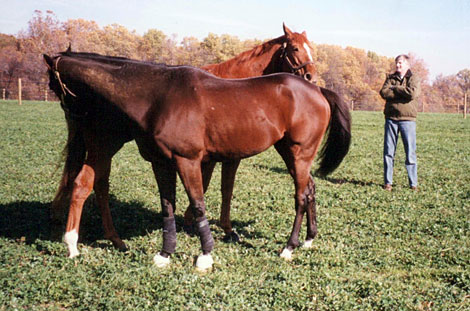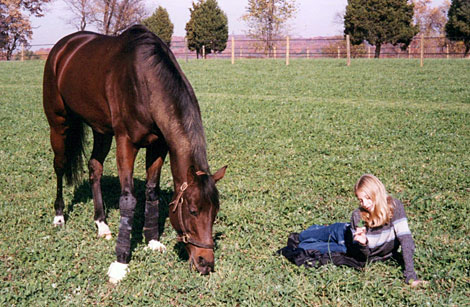In 1998, I made several visits to Michael Dickinson’s Tapeta Farm and witnessed first-hand the struggle Dickinson and his crew had getting Da Hoss back to the Breeders’ Cup Mile off only one minor race in two years. I wound up covering the Mile; my final assignment for the newly purchased DRF, for whom I had worked for 29 years. My family and I then visited Tapeta the week after the Breeders’ Cup, during which time I took the photos published below this column. Watching the Mile still gives me goosebumps after 15 years.
We have a tendency to use the word miracle to describe a feat of extraordinary skill; a feat that stands out so far and above the norm we feel compelled to give it an ethereal quality.
To label Da Hoss’ second victory in the Breeders’ Cup Mile the “Miracle Mile,” sounds catchy enough and boosts the race’s historical significance, as if it were pre-ordained, with some higher source guiding Da Hoss and trainer Michael Dickinson through that tumultuous 1998 season.
In re-telling and re-working this remarkable story, one thing became perfectly clear. The horse and his trainer and staff all combined to write a script that, by normal and even above normal standards, should never have seen the light of day. The fact that it did, complete with happy ending is, well, I don’t know, a miracle?
Da Hoss’ victory in the 1996 Breeders’ Cup Mile at Woodbine and his subsequent retirement would have made for a wonderful story in itself. But Dickinson, the masterful storyteller, does not settle for wonderful endings when he can go beyond wonderful. Throughout his racing career as a steeplechase rider and trainer in England and flat trainer in America, Dickinson has accomplished the seemingly impossible with his extraordinary skills, while existing in his own realm far beyond the conventional.
Known as “The Mad Genius,” Dickinson has always been a perfectionist and not even the smallest detail escapes him. His vast network of brain cells always seems to be active, and he runs around like a revved up a machine where the gears are in constant motion. Tell Dickinson, who gave his horses three eggs and a bottle of Guinness Stout each day, he can’t do something and it drives him even harder. His reputation for accomplishing extraordinary feats first became evident throughout Europe when he did the unthinkable on two occasions: saddle the first five finishers of the prestigious Cheltenham Gold Cup and win 12 races in a single day, both of which earned him a place in the Guinness Book of World Records.
After moving to America, he, along with his partner in life Joan Wakefield, trained at the Fair Hill Training Center before creating a scenic and pastoral horse haven he called Tapeta Farm in nearby North East, Md.
It was there that Dickinson would venture into the world of synthetic surfaces, inventing the Tapeta surface, which eventually would be installed at Meydan Race Course in Dubai and various tracks in the United States.
Before we get to the events of 1998, it's best to start with Da Hoss himself and the numerous physical ailments that plagued him his entire life. As a foal, he developed an infection in his hoof and it rotted away a quarter of his coffin bone. As a yearling, he developed two bone spurs in his hocks, which eventually became arthritic. Those two problems were the root of most of Da Hoss' future problems.
As a yearling, he sold at the Keeneland September yearling sale for a mere $6,000 by Wall Street Racing and wound up at Turf Paradise in Arizona as a 2-year-old. He had the dubious distinction of being the lowest-priced Gone West sold that year. They thought at that price, if he couldn’t cut it as a racehorse they would make him a pet. But he showed right from the start he possessed tremendous speed, blazing six furlongs in 1:07 1/5 in the ATBA Stakes, the fastest time ever recorded by a 2-year-old. It was then that Jack, Art, and J.R. Preston of Prestonwood Farm, purchased 85% of Da Hoss, even though two veterinarians had failed the horse.
At 3, he won graded stakes on dirt and turf on both coasts from six furlongs to 1 1/8 miles, while making three separate trips to California.
As a 4-year-old, he won stakes at Saratoga and Penn National before capturing the Breeders' Cup Mile at Woodbine, defeating the top-class French colt Spinning World, who would win the BC Mile the following year at Hollywood Park. Prior to the race, Dickinson was walking the course with Wakefield, who had warned him ahead of time he would not be happy with the soft going. Dickinson told Wakefield to go put on a pair of stilettos. When he was a steeplechase rider in England, he had been dating a model, who went along with him one day as he walked the course before the races. Dickinson had determined that the left side of the course was better, but the girl disagreed, telling him her high heels were sinking in deeper on the left side than the right. It was then that Dickinson realized the best way to test the turf was with high heels, and he would use that method for years, enhancing his reputation even further as a Mad Genius.
After going through his ritual before the ’96 Mile, Dickinson mapped out exactly where he wanted jockey Gary Stevens to be every step of the way.
Following his resounding victory at Woodbine, Da Hoss disappeared from the racetrack for two years. All the time the gelding was away battling physical problems, Dickinson had dreams of a second Breeders' Cup Mile victory, but this seemed more of a pipedream. Even for The Mad Genius, it would take a bit of madness and lot of genius to make it come true.
In 1997, Da Hoss developed a problem with his tendon in March, then ankle problems in June. In September, he went lame behind for two to three weeks. Before Dickinson knew it, the entire year was lost, and it wasn't about to get better. In February, 1998, Da Hoss developed some heat in his tendon, the result of a tear, and Dickinson had to stop on him. He walked him for a month and then jogged him for a month, but when he was just about ready to begin serious training, Dickinson noticed he was moving horribly and had to give him more time let him work his way through it.
All the while, Da Hoss was frolicking about with his best friend Boomer, a 9-year-old who went by the name Business is Boomin. Dickinson had already performed a “miracle” with Boomer, which gave him hope he could duplicate it with Da Hoss. All he did was get him to win three straight races in 1997...off a five-year layoff. That was unheard of. On May 8, 1997, exactly five years to the day since his last start, Boomer won a $15,000 claiming race at Garden State Park by 6 3/4 lengths. Boomer and Da Hoss had become so inseparable, Dickinson couldn't afford to risk losing Boomer in a claiming race, so he jumped him up to allowance company, and he won both, at Monmouth and Laurel. After a second and a fourth, Boomer went lame again and was on the shelf for another 10 months. Dickinson finally got him back the following June, and Boomer proceeded once again to win his first three races back, all at Delaware Park.
A great deal of the credit for Boomer's remarkable comeback went to Wakefield. The horse had such soft bones that every time he'd train over the dirt he went lame. Wakefield turned him into a pony and would ride him to a friend's barn each morning for her coffee break. She began to notice him feeling stronger by the day, and that's when it was decided to try to bring him back to the races.
In April 1998, Dickinson moved to his 200-acre Tapeta Farm for training. Boomer and Da Hoss were stabled next to each other and shared the same paddock, becoming inseparable.
"Da Hoss worships Boomer," Wakefield said at the time. "He follows him around like a little dog."
All during 1998, Dickinson kept thinking Breeders' Cup for Da Hoss. The other devoted members of Dickinson's crew who worked feverishly on Da Hoss' aches and pains were groom Miguel Piedra and exercise rider Jon (Jon Boy) Ferriday. In January, Dickinson called Gary Stevens’ agent, Ron Anderson, and told him he was getting Da Hoss ready for the Breeders’ Cup and he must ride him.
On April 29, Dickinson had an ultrasound taken of Da Hoss' tendon and did little with him for a week, eventually walking him each day for almost an hour along the tree-lined paths with Ferriday on his back. On May 30, Da Hoss began jogging, and after a week, the jogs were increased to two a day. He finally began light gallops on June 21. Four days later, Dickinson faxed a letter to owners Art, Jack, and J.R. Preston, which read:
"Da Hoss' tendon was scanned last week and our vet was unable to find any problem...The technician at New Bolton Center says Da Hoss' tendons heal very quickly...I've worked out a plan to get him to the Breeders' Cup with just one race before. I have time in hand if nothing goes wrong."
But those final words "if nothing goes wrong" came back to haunt him. It didn't take long for something to go wrong. On July 10, Dickinson sent the Prestons another fax:
"Dr. Ross examined Da Hoss today, and he thought he had muscle atrophy on the left hind and was moving worse than he had ever seen him...It is disappointing to us all...My goal is still the Breeders' Cup."
All the while, Piedra rarely left Da Hoss' side, working on him constantly, especially the arthritis in his joints, which required extensive massaging. Then there was the hosing of the horse's hocks. Plastic tubes were attached to his knees, allowing for a continuous trickle of water to drip down his legs. Piedra spent six hours a day in the stall with the horse, rubbing him, giving him physiotherapy, massage treatments, ice treatments, and laser treatments.
Wakefield was the one who was able to get into Da Hoss' head. Like with Boomer, she could read him like no one else and would know if something was going to go wrong two days before anyone else. Ferriday would walk the course every night before Da Hoss breezed, looking for the perfect ground. Once he found it, he would move the cones to the spot where he wanted Da Hoss to be. Also instrumental was farrier Gary Reynolds, who shod Da Hoss and worked on his feet.
Despite all this, the vet reports weren't encouraging, and no one except for Dickinson and his team felt Da Hoss had any shot of making the Breeders' Cup.
One of Da Hoss' problems was that he often was too willing and would do more than he was supposed to. He was competitive in his gallops even to the point where he would try to pass Wakefield's car as she drove alongside the track.
It wasn't until August that Da Hoss was able to begin breezing. It was only three months to the Breeders' Cup. But the breezes continued on a regular basis. He just might make it after all. On Sept. 15, Dickinson faxed the Prestons:
"Da Hoss breezed quite well on Saturday. He has now had seven breezes and probably will require three more...I feel he's moving as well as he did when he won the Breeders' Cup or maybe even better. He remains as competitive as ever...We all know that he does have aches and pains, and on a nuclear scan he lights up like a Christmas tree...We're all holding our breath at the moment, and it will indeed be a miracle if he wins the Breeders' Cup again this year. But miracles do happen."
Those aches and pains Dickinson referred to would flare up following every breeze and the horse would become stiff. Dickinson was afraid to work Da Hoss long because of his fragility. To get the horse back in a racetrack mode, he sent him to the Meadowlands, where Da Hoss breezed a slow seven furlongs in 1:30. Between the tendon injury and all his other maladies, Dickinson had no way of knowing how fit Da Hoss was. He only knew one thing: he needed to find a prep race before the Breeders' Cup.
He had two races in mind, the Cliff Hanger Stakes at the Meadowlands on Oct. 8 or an allowance race at Belmont two days later. But rain that weekend washed out those plans, as Dickinson did not want to subject Da Hoss to a soft grass course. And even if he wanted to run, there was a good chance both races would be taken off the turf. The only alternative was to go straight into the Breeders' Cup, but Da Hoss had no Breeders' Cup points and no wins. With so many accomplished horses pointing the race, the selection committee was not about to include a horse who had not raced for two years.
On Oct. 1, Dickinson called Anderson, who originally had been told Da Hoss would have a series of preps, each one designed to move him forward and have him peaking for the Breeders’ Cup. With the Breeders’ Cup less than a month away, and Da Hoss not having had a race, Anderson put Stevens on the Michael Stoute-trained Among Men, which infuriated Dickinson.
“We haven’t seen your horse in two years,” Anderson explained. When Dickinson asked Anderson who he was riding and was told Among Men, he said, “Number one, I’ll book you, and number two, you’re on the wrong horse. I’ll bet you $1,000, wherever we finish, whether it’s first and second or last and next-to-last, we’ll finish in front of Among Men.”
A Desperate Dickinson turned to Lenny Hale, racing secretary at the new Colonial Downs in Virginia and asked him to write a race for Da Hoss, which he gladly did, a nine-furlong allowance race on Oct. 11. The race filled and remained on the turf. Da Hoss, after nearly two years, finally made it back to the races. Sent off at 3-5 against five opponents, Da Hoss stalked the early pace under Carlos Marquez Jr. and won by three-quarters of a length.
On Oct. 21, Dickinson, after observing Da Hoss carefully for 10 days, sent a final fax to the Prestons:
"I'm happy to say he came out of his last race as good as we could have expected...Two weeks ago I felt we had a 50-50 chance to make the Breeders' Cup. Now I think we have a 65% chance of being there fit and well on that day."
After two breezes at Tapeta, Da Hoss shipped to Churchill Downs. Dickinson had contacted Angel Cordero Jr. and booked John Velazquez for the Mile. The Breeders' Cup was eight days away. But Dickinson realized that training at Churchill and training at Tapeta were like night and day. At home, Da Hoss was used to going out at the crack of dawn, but the grass course at Churchill did not open until about 9 o'clock. So, for three hours, an anxious Da Hoss had to remain in his stall, unable to train. Dickinson was not happy and was sorry he had brought the horse so early.
Once on the track, Da Hoss had to wait for others to train first, and Dickinson was worried about the horse having to train over a course that had already been chewed up. When he worked him on the Monday before the race, he realized to his dismay that his two-way radio wasn't working and he was unable to convey instructions to Ferriday. Dickinson went upstairs to the press box and watched the work from the porch. It was obvious just looking at him, he was upset and distressed over the turn of events. After all the work he had put in to get Da Hoss here, he was now in danger of having it all blow up a week before the race. He had no way of communicating with Jon Boy and Da Hoss would have to work over a less-than-ideal turf course.
His worries were for nothing. Da Hoss glided over the course, breezing five furlongs in 1:03 1/5 and did it in hand, striding out beautifully. Dickinson was thrilled with the way Da Hoss went, but fearing he still wasn't 100% fit, he had Ferriday blow him out a bit down the stretch on Thursday.
The night following the Monday work, Dickinson, for the first time in weeks, slept through the night.
As he said, "It's been an emotional roller coaster, especially the last six weeks. There were times he was working so well I couldn't sleep with excitement. Then there were times when things weren't going very well and I couldn't sleep with worry."
By now, Dickinson had moved from stilettos to a penetrometer to test the course, and was seen out on the course, walking it and testing it on six different occasions, looking for the best ground. As he did with Gary Stevens in ‘96, Dickinson drew a map of the turf course, using different colors for the different paths, designating where he wanted Da Hoss to be at each stage of the race. He brought the map to the jock's room the morning of the race and showed it to Velazquez.
After the horses were saddled, the Da Hoss team lost track of each other and dispersed in different directions. Dickinson wound up in a small office in the tunnel, Piedra and Ferriday found a place on the apron, and Wakefield, who had taken the wrong elevator, had to watch the race on a TV monitor in the press box.
What happened after that will forever be etched in Breeders’ Cup lore. Velazquez, unable to follow Dickinson's directions, was forced to move early on the far turn after getting bumped and having to check on the first turn. Rallying four wide, Da Hoss, sent off at 11-1, hit the front at around the three-sixteenths pole. This was too early, and Dickinson was upset, fearing the horse had moved too soon. Da Hoss was on the lead with more than a furlong still to run.
From out of the pack came the Neil Drysdale stretch runner Hawksley Hill, who charged up alongside Da Hoss inside the eighth pole and actually got his head, then neck in front at the sixteenth pole and looked about ready to drew clear. Da Hoss, with only one allowance race under him in two years, had made a gallant effort, but he was a beaten horse. With no one in the 14-horse field threatening from behind, it appeared obvious Da Hoss would settle for second, a tremendous achievement in itself.
But then the improbable happened. Da Hoss dug in and came battling back, his neck fully stretched. No one could believe it. He could actually come back and win it. Da Hoss kept reaching for more and with one final surge he stuck his head in front right on the wire. A stunned Tom Durkin, calling the race, bellowed: "Oh, my! This is the greatest comeback since Lazarus!" NBC host Tom Hammond was just as excited and surprised. "We said Michael Dickinson was a mad genius," he stated. "How in the world can they have this horse ready with one race in two years to come back and win his second Breeders' Cup?"
A head-on photo of the finish shows the dogged determination of Da Hoss as he crosses the finish line with his teeth tightly clenched.
Dickinson stood on the track as if in a daze, trying, but not succeeding, to hold back the tears. Wakefield rushed down from the press box and she and Dickinson embraced, both now weeping uncontrollably. Nearby, Ferriday could barely get a word out and had to walk off by himself to regain his composure.
"I can't believe it," a teary-eyed Ferriday said. "I can't believe he's done it. He's a machine. Michael, Joan, and Miguel deserve all the credit. I'm just a passenger on him."
With all the pandemonium arround them, all four had to be thinking back to a much quieter time and place at Tapeta Farm where the miracle of Da Hoss' fairy-tale comeback was born. All the frustrations, sleepless nights, and feelings of hopelessness they endured had erupted into one euphoric and emotional moment that will be forever frozen in time in Breeders' Cup history.
One of the first to congratulate Dickinson was Gary Stevens. As Dickinson would say later, “Ninety-nine times out of a hundred (Ron Anderson) would have been right. He’s the best agent for a reason. But on rare occasion, a horse like Da Hoss proves you wrong.”
Sir Michael Stoute, trainer of Among Men, walked up to Dickinson, patted him on the back, and said it all with one word: "Maestro."
Dickinson later reflected back to when it seemed all the work would prove fruitless: "I remember saying to everyone after he was so stiff this fall that we're going to have to stop on him; we can't carry on,” he recalled. “There were a lot of tears. Miguel has four children and he was crying. Joan was crying. Jon Boy was crying."
Two months later, in the Churchill Downs winner's circle, they all were crying once again.

Da Hoss and Boomer strike a proud pose a week after the '98 BC Mile.

Da Hoss and Boomer side by side as usual.

Michael Dickinson felt like a proud father watching his two star pupils.

Da Hoss and Boomer vie for the attention of a young visitor.

Just a quiet morning at Tapeta with Da Hoss in the wake of one of the great races in BC history.




